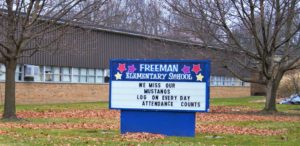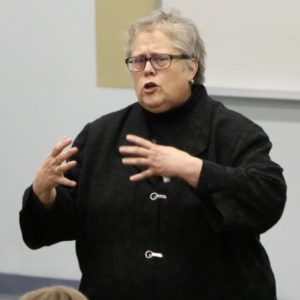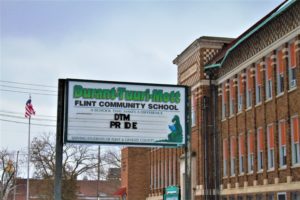By Harold C. Ford
Flint Community Schools’ (FCS) K-3 students began returning to school buildings March 15. Students in grades 4-12 began returning March 22.
At its meeting on March 17, the Flint Board of Education learned that 81 hydration stations (drinking fountains) funded by billionaire Elon Musk and the C. S. Mott Foundation are not yet operable. Additionally, only 40 of 300 PUR water filters for sink faucets ordered by the district had been received.
As students return to buildings across the state, schools have become the number one source of COVID-19 outbreaks, surpassing nursing homes, prisons, and worksites, according to state government sources.
Back to school
Flint students with last names that start with letters A-L, who choose to do so, report to school buildings on Mondays and Tuesdays. Those with last names that start with letters M-Z report on Thursdays and Fridays. Buildings are closed on Wednesdays for cleaning and disinfecting.

Freeman elementary school in the south end of the Flint Community School District. (Photo by Tom Travis)
Students are expected to report for remote/online learning during those days they are not in the buildings.
A January 2021 poll of FCS families indicated that about 40 percent of FCS families favored a return to face-to-face instruction. MLive reported on March 15 that, according to FCS Assistant Superintendent Kevelin Jones, “around 70 percent” now say they would like to return. (FCS officials did not respond to EVM’s query about attendance figures for its first back-to-school week(s) in more than a year.)
“I appreciate all the work that has been done since March 2020 to make sure our children have gotten their education…to have classrooms ready…to pull things together, to make something from nothing,” Board Vice President Vera Perry said about the schools’ reopening.
“We went that extra mile to make sure our kids were safe,” added Joyce Ellis-McNeal, the board’s assistant secretary-treasurer.
“I haven’t received any emails or phone calls about anything that’s bothering anybody,” said Danielle Green, treasurer. “I am very pleased.”
On March 15, the Michigan Department of Health and Human Services reported 169 new clusters/outbreaks of COVID-19 in K-12 school settings (classroom, before/after school programs) in the state. In Region 3, which includes Genesee County, 22 new clusters/outbreaks were reported.
“The largest number of outbreaks are in kindergarten-twelfth school settings…” reported Sarah Lyon-Callo, director of the Bureau of Epidemiology and Population Health at the state health department, on March 17. Lyon-Callo said that children ages 10-19 now have the highest COVID-19 case rate in Michigan.
“The classroom environment itself has not been a strong signal for outbreaks,” explained Lyon-Callo. “It tends to be more the activities associated with schools, and including sports, but not limited to sports.”
State officials announced on March 20 that young athletes, from middle to high school, must get COVID-19 antigen tests before games and practices starting in April.
Hydration stations inoperable
Laura Sullivan, professor of mechanical engineering at Kettering University (KU), told the board at its March 17 meeting that hydration stations, funded with donations from billionaire Elon Musk and the C.S. Mott Foundation, were not yet operable.
FCS was gifted $430,350 in mid-2018 to purchase, install, and test hydration stations that utilized a three-step process of drinking water filtration: first, an ultrafilter (to screen out particles); then, a standard carbon block filter (to remove lead); and finally, ultraviolet light (to kill bacteria).

Laura Sullivan, professor of mechanical engineering Kettering University. (Photo by Jan Worth-Nelson)
Installation, testing, flushing, and maintenance is being overseen by a team of KU students and staff, including Sullivan and Michelle Ammerman, a professor in the KU Department of Chemistry and Biochemistry. Other partners in the project have included the State of Michigan, the University of Michigan, and Brighton Analytical, LLC.

Michelle Ammerman, professor, Dept of Chemistry and Biochemistry (Photo source: Kettering University webstie)
Sullivan explained that the project had been delayed by COVID-19, a nonresponsive manufacturer, and failed testing.
Testing of the hydration stations involved two phases: “challenge testing” in a laboratory environment; and “field testing” inside the school buildings.
The early failed tests will bring modifications of the hydration stations that will substitute a prefilter for the ultrafilters and carbon filters and remedy a problem with the firmware (permanent software) necessary for the functioning of the ultraviolet light filter.
Sullivan assured a wary board, “You will know that” the filters are removing lead and bacteria.
“You’ve taken it upon yourself (without compensation) to make sure that our staff and our students and our teachers are safe,” said Laura MacIntyre, board vice president. “I can’t thank you [Sullivan, Ammerman, KU] enough.”
“We would be nowhere without Elon Musk,” Sullivan said.
Lead in the water
Sullivan’s board presentation also included the results of testing for lead in the school buildings. The percent of water taps with at least five pbb (parts per billion) of lead is shown below for each building.

Durant-Tuuri Mott school on University Ave near Kettering University. (Photo by Tom Travis)
Brownell: 74%
Doyle-Ryder: 59%
Durant-Tuuri-Mott: 47%
Eisenhower: 23%
Freeman: 52%
Holmes: 58%
Neithercut: 85%
Northwestern: 100%
Pierce: 34%
Potter: 32%
Southwestern: 78%
The Environmental Protection Agency (EPA) has set the maximum contaminant level for lead in drinking water at zero.
Short of filters for sink faucets
As he had at its February meeting, William Chapman, FCS director of operations, informed the board that the district was still short of PUR filters for sink faucets. Chapman said that only 40 faucets had been received from the City of Flint; an additional 300 have been requested.
“I would have voted ‘no’ for the return (to school buildings),” Green declared.
“I’m at the mercy of the manufacturer,” Chapman responded.
Continuity of learning
Kevlin Jones presented a report titled “Extended Continuity of Learning” to members of the Flint panel. Highlights included:

Kevelin Jones, assistant Superintendent. (Photo source: FCS website)
- Student enrollment: 3,260. Daily Attendance Rate: 75 percent.
- NWEA test completion rate (district total): Math, 82.6 percent; Reading, 82.1 percent. (Northwest Evaluation Association, standardized testing)
- Student growth rate (fall 2020-winter 2021; district): Math, 43.6 percent; Reading 41.1 percent
- DIBELS (K-3; at benchmark or above; district): 16.8 percent (Dynamic Indicators of Basic Early Literacy Skills)
“Hopefully we can get these scores up,” Ellis-McNeal said,
A recording of the March 17 FCS Board of Education meeting can be accessed at You Tube.
The next meeting of the FCS board is scheduled to begin at 6:30 p.m. April 14. The public can attend the meetings virtually by registering at the district’s website www.flintschools.org.
Questions and/or comments for FCS officials can be submitted to the following internet address: fboe@flintschools.org. Also, the email addresses of various FCS officials can also be found at the district’s website: www.flintschools.org.
EVM Education Beat reporter, Harold Ford, can be reached at hcford1185@gmail.com



You must be logged in to post a comment.